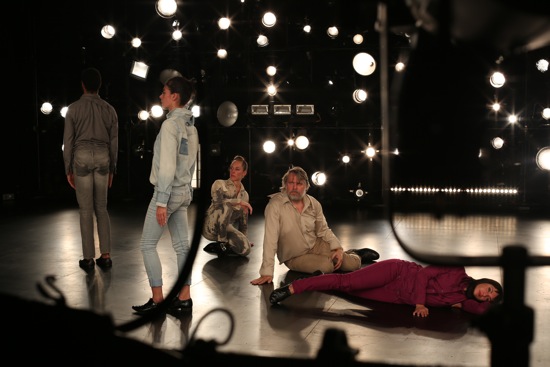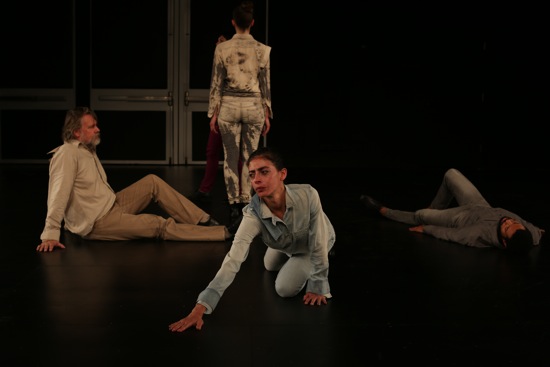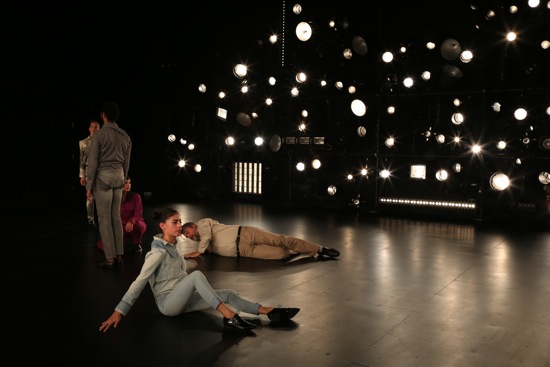The Kitchen and Performa present Maria Hassabi’s dance installation, Premiere.

(L to R): Andros Zins-Browne, Maria Hassabi, Biba Bell, Robert Steijn, and Hristoula Harakas in Hassabi’s Premiere. Photo: Paula Court
The lobby of The Kitchen opens onto far-west 19th Street. Trucks could—and perhaps once did—drive right in. The night I go there to see Maria Hassabi’s Premiere, that area is as packed with people as the place’s full name (The Kitchen Center for Video, Music, Dance, Performance, Film, and Literature) is packed with words. Hot with proximity and anticipation, we wait for the inner doors to open. Some people grouse: Isn’t this supposed to start at 8? Tonight’s house manager, choreographer Adrienne Truscott, calls out over the hubbub that as soon as we get into the theater, we’ll understand why we’re being made to wait.
Swarming through the finally opened doors, we do.
The rows of seats that we must get to are against the far wall, and between us and them are posed Premiere’s five performers, as immobile as mannequins in a department store window, but far more interesting. They are spaced out in a row, facing us. The tide of spectators splits to avoid stampeding them (after we’re seated, the black floor retains our grayish, circumventing tracks).
I can’t remember ever seeing so many lights in a high-ceilinged, black-box theater. The lighting design by Zack Tinkelman and Hassabi places five rows of three stacked grids on either side of the performing area. Each of these metal trellises holds as many as eight theatrical lamps of different sizes and shapes. There must be over 200 instruments emitting white light at full power—all of them aimed at the performers. Whose backs we are now regarding. Hassabi sits with her feet stuck out; Andros Zins-Browne reclines, leaning on his elbows; Hristoula Harakas and Biba Bell stand; Robert Steijn (the Robert of Hassabi’s Robert and Maria) also reclines, but turned slightly on his side. Fans whir. The doors through which we entered are closed.
This is when I realize that I forgot to tell my husband, who’s sitting beside me, that Hassabi is a master of slowness and stillness, that her pieces are like art installations brought to life by dancers. The audience seems to know what to expect, however, and, given that Hassabi has shown works of hers in many cities of the world and received much recognition, they should not be anticipating high-powered dancing.

(L to R) Robert Steijn, Biba Bell, Maria Hassabi, and Andros Zins-Browne in Premiere. Photo: Paula Court
Even though the performers are placed fairly close to one another, they seem curiously isolated in this bright, bright arena. Like the figures in Milet Andrejevic’s 1960s paintings of Central Park, they inhabit the same space, but have different agendas. Eventually, I will discover what gives me this impression: Hassabi created separate solos for them, then placed them together.
Forget your ideas about what constitutes a solo. If these five people were to execute the choreography at a speed more or less “normal,” you would see them moving between various ways of sitting, lying, standing, kneeling, facing a different direction, taking a step or two. But they move extremely slowly, and in increments—sometimes so slowly that you are not sure that they are moving. You scan the tableau, sleuthing for motion, and become a connoisseur of infinitesimal adjustments. Harakas, whose jumpsuit is a vivid pink—brighter than anyone else’s clothing—begins to make her right foot turn by means of tiny jerks. Her heel squeaks faintly against the floor. Nothing else about her moves. I take my eyes off her and notice that Zins-Browne has slightly shifted his weight so that one of his supporting arms is bent more than the other. Hassabi has started to slide her hands back, as if she plans on lying down minutes from now. It takes a long time for Bell to turn out one leg and straighten it, for Steijn to sit.
What these performers are doing is exquisitely difficult. Virtuosic even. Hassabi seems to orchestrate pauses, so that seldom do you notice all of them moving at the same rate simultaneously, and often such pauses involve their stopping in a position that takes strength and endurance to maintain. Every tiny detail has been carefully choreographed; if Harakas’s eyes glance sideways, that’s no accident. The title, Premiere, is no accident either. As Hassabi has said in interviews, every performance is, by its very ephemerality and immediacy, a premiere. And these five solos may not jibe identically at every performance. At a certain point, the five are in a diagonal that slants from one person’s lying position to the fifth person’s standing position. A coincidence, or a well-plotted event?
Alex Waterman is credited with sound design, so the small spitting noises that become audible must be part of that and not a lighting issue. I think of the way a frying pan spits when you spray water on it to ascertain if it’s really hot. When it recurs later, it’s more like rain hitting a window.
That the performers are alone together becomes most obvious when their separate solos take them into close proximity. For a few seconds, Harakas and Bell stand very close together, and I start dreaming about an encounter, but they move on. You might suppose that Hassabi and Zins-Browne are gazing at each other, but their eyes do not engage.

Alone together in Maria Hassabi’s Premiere. At left, Biba Bell. Andros Zins-Browne, and Hristoula Harakas. Maria Hassabi seated, Robert Steijn lying down. Photo: Paula Court
Time. Moves. Very. Slowly. Harakas, a marvel of steadfast control, begins to slide one foot forward. Farther. Farther. Could she be contemplating a split? Surely not. No, she stops in a deep, deep lunge, pauses, and draws her back leg in. I have no idea how long I’ve been watching without changing my own position, but I’m aware of others beginning to shift in their seats. I cross one leg over the other. I check my watch to establish the difference between perceived duration and actual lapsed time. It is 8:49.
And it is excessively hot. With remarkable tact, the lighting softens. Whew! Then it begins its own slow dance. The side panels fade up again. Then dim. Then go out and are replaced by lights from behind and above the spectators. The side lights sneak back in. Am I imagining that the pace is picking up slightly? There is a sound of far distant singing; the ticking returns. At 9:09, a major event: Harakas travels at a snail’s pace to the wall where the entrance door is. What can she be planning? Minutes pass. If she was thinking about leaving, she discards that idea and retraces her steps.
It is interesting how I impute intent to Premiere‘s slow, inexorable maneuvers. I think this is because the dancers’ physical strain and the intensity of their focus can be read as emotion. Their whole being is invested in that one hand sliding along the floor, in that one leg striving to cross over the other. I see them sweating and breathing hard and can imagine them cracking under the stress. But, of course, they don’t.
Suddenly, I infer shared intent. Can it be? Yes! Very slowly the performers are returning to their initial positions, settling into them, making last-minute adjustments. Here they are, exactly as we first saw them, only now they are facing in the opposite direction. The lights get brighter and brighter and brighter. Then they go out.
The performers don’t move when we applaud, when we cheer, or when we leave our seats and steer our way around them. I look over my shoulder as I pass through the door. They are still in position, their backs to us, contemplating the empty seats.

Hi! Someone in my Myspace group shared this site with us so I came to check
it out. I’m definitely enjoying the information. I’m bookmarking and will be
tweeting this to my followers! Excellent blog and superb design and style.